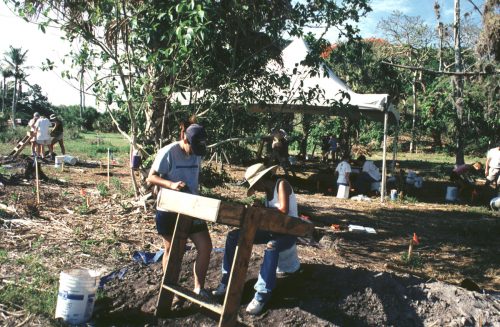Archaeological excavations at the site of the future RRC teaching pavilion are finished. In compliance with the Lee County Land Development Code, the Randell Research Center (RRC) hired us to determine the impact of the planned construction on archaeological deposits.

Digging a series of small tests in March 2001, we found archaeological deposits across the project area, east of Waterfront Drive and north of Brown’s Mound. Results of these tests prompted more intensive excava- tions, conducted during a Florida Gulf Coast University (FGCU) archaeological field school from May 21 to June 22, 2001. These pits revealed that the area is covered by fill dirt. Ted Smith once told us that this fill was drag-lined in from the bay during the early twentieth-century construction of Pineland’s sea wall. Additionally, we identified at least three ridges running north-south, generally parallel. The ridges are mainly composed of shell midden — discarded shells, dirt, fish bones, and charcoal. These date to the Caloosahatchee IIA period (A.D. 500-800), judging from pottery found in them. The shell-midden layer overlies an earthen one, Zone 5. Deeper still, there is another layer of shell midden, with many oyster shells and only plain, sand-tempered pottery sherds, a characteristic of the Caloosahatchee I period (A.D. 1-500 at Pineland).
When we exposed the lower portion of Zone 5, we saw numerous circular sand-filled cavities extending through the compacted sediment. There were two distinct size ranges, averaging 4 and 8 inches in diameter. We believe that this part of Zone 5 might represent the remains of a “living floor,” and probably of a structure, which we estimate to date to about A.D. 400-600. Because Calusa structures are so poorly known, we decided to expand the excavation to try to find the structure’s limits and learn more about it. This additional exploration was funded by the RRC, through a grant from the Wentworth Foundation. We have now finished a preliminary report, and we begin detailed analysis of our findings in September, assisted by FGCU students.
Designed by Fort Myers architect Jeff Mudgett (Parker, Mudgett, and Smith, Architects) and engineer Tim Keene (Keene Engineering), the pavilion and parking area were planned to minimize impact to the archaeological deposits by placing up to 3 feet of fill over the construction areas and by placing the building up on pilings. This plan, in combination with the archaeological study, assures that no significant archaeological information will be lost due to the construction. The pavilion dig is contributing new information on Pine Islanders who lived some 1500 years before us.
This article was taken from the Friends of the Randell Research Center Newsletter Vol 1, No. 3. September 2002.